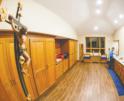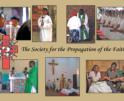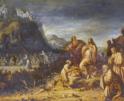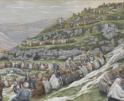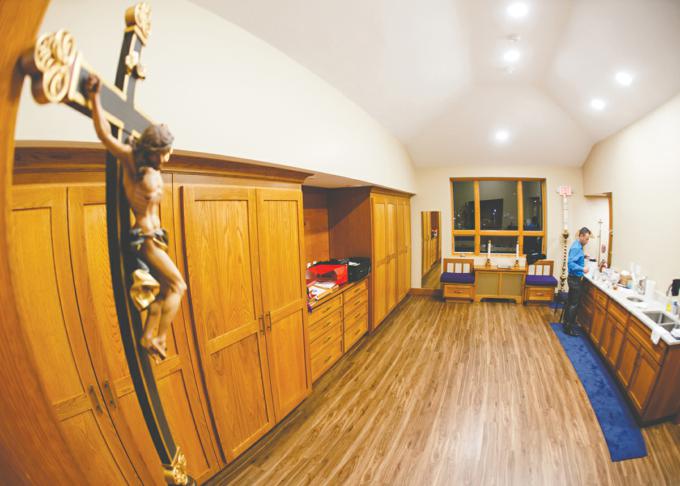
Faith
The ordo is a daily reminder to us that the whole of the liturgy is an act of the church, not of any individual. It really says, "Here's how we will praise God today."
Continuing from last week on updates and suggestions: First, the third text that is currently in the translation process.
Roman Martyrology
When the first Latin edition of this book was released in 1984, I asked one of my classmates who was visiting Rome to get me a copy, which he did. In his own inimitable style, he said when presenting it to me, "O'Grady, this is great; no more boring green days." He was referring to the fact this book permitted the celebration of any saint listed in it on any day of the year, not otherwise assigned a feast, etc. He'd only have to wear green vestments on Sundays in Ordinary Time. He also added, "Only God knows how long it will be before the bishops get around to translating it." He is now deceased, and 40 years later, the process of translation and preparation of the Martyrology is underway.
This book contains saints who are martyrs but also those who are not. And it presents the "problem" that there are always more saints -- thanks be to God! How this ultimately appears, in print or online, may be influenced by the constant additions of saints to the church's "honor roll."
Websites
Often, readers look for additional information regarding one or another topic of one of these columns. There are many good websites managed by dioceses or liturgy organizations.
Here are a few. If you have suggested sites, let me know, and I can cite them in a future column.
-- LA Liturgy -- This is an excellent site: lacatholics.org/worship. It has the bonus of being bilingual for Spanish-speaking ministry. You can sign up for Los Angeles's excellent monthly liturgical calendar, which is extremely helpful for liturgical ministers.
-- Philadelphia of the Latins -- Continuing to another East Coast diocese, our sister diocese and archdiocese (Boston and Philadelphia of the Latins were both made dioceses in 1808, and metropolitan sees in 1875) has many useful documents, updated and increased regularly. Keep in mind that some of the issues are specific to Philly, but nevertheless, they are helpful. Www.odwphiladelphia.org.
-- Brisbane -- The Australian Archdiocese of Brisbane is very active. It publishes a free quarterly newsletter; sign up for it here: www.liturgybrisbane.net.au.
-- FDLC -- The Federation of Diocesan Liturgical Commissions, of which our archdiocese is a founding member and of which the late Boston liturgy giant Msgr. Frederick R. McManus was an original member and long-time board member, provides not only documentation but also online formation material. Recently, there was a five-part series on the new version of Holy Communion and Worship of the Eucharistic Mystery outside Mass and an upcoming multipart series for the new Order of Christian Initiation of Adults. Most of the documents are available in both English and Spanish at fdlc.org.
Well-equipped sacristy
Over the past several months, I have worked on a document called "Your Well-Equipped Sacristy." You might call it either a draft or a work in progress. It's in Excel spreadsheet format, and you can download it here: tinyurl.com/mw2zs7nv.
Initially obtained in a much more compact version, I worked with the original author and added a lot of detail. I asked several others who made valuable liturgical and non-liturgical suggestions.
The Excel format allows parishes -- including cathedrals, other churches, shrines, chapels, and any type of worship site with a sacristy large or small -- to adapt this for themselves. Additions and deletions can easily be made.
As always, suggestions are encouraged and welcome.
Calendars and ordo
While we are a bit over halfway through our civil calendar year, we are almost two-thirds through the liturgical calendar year.
In a previous article, I addressed the document that created the basics for all calendars in the Latin Church. If you have a Catholic calendar on paper, or more likely on an app, you will see what days, feasts, colors, readings, etc., are prescribed for each day. It is really a combination of a calendar and an ordo.
The calendar simply lists the various liturgical days, assigns their rank -- solemnity, feast, memorial, ferial (i.e., weekday) and, of course, assigns the date of the month. Keep in mind that dioceses and religious orders can and do have variations on the theme of the General Calendar. This is why an "ordo" is needed, at least in every sacristy, and a priest will often have one on his desk so he can check the details in the ordo both for Mass and the Liturgy of Hours.
An ordo will have notes and citations about the rank of the feast on a particular date in a specific year. This is where to find the proper prayers and readings, vestment colors, and options, if any, for the respective day. The ordo is a daily reminder to us that the whole of the liturgy is an act of the church, not of any individual. It really says, "Here's how we will praise God today."
Next week, we'll start a 10-week series about roles or ministries that contribute to the more effective celebration of the liturgy.
A Well-Equipped Sacristy
If the architecture of the church permits, having two sacristy spaces is helpful: a vesting sacristy where the priest and deacon prepare for Mass, and a working sacristy where the vessels and items needed for Mass are prepared, and servers can vest.
For sacristies connected to a religious institute books (missals, lectionaries, ordos) as well as any other items specific to that institute should be included within respective categories and on your particular list.
Sacristies in cathedral churches require additional items in the respective categories. In this list some of those noted with *; additional such items may be added to your particular list within the respective categories.
This is designed for parishes. Others may readily adjust the list for their particular needs.
Https://www.americamagazine.org/faith/2023/03/16/sacristan-church-teaching-244930
https://ltp.org/products/details/ELSAC3/guide-for-sacristans-third-edition
https://ltp.org/products/details/SLSAC3/manual-para-sacristanes-tercera-edicion
https://ltp.org/products/details/SACMNL2/sacristy-manual-second-edition
Ritual Texts
Anointing of the Sick and their Pastoral Care
Book of Blessings
Book of the Gospels
Collection of Masses for the Blessed Virgin Mary-Lectionary
Collection of Masses for the Blessed Virgin Mary-Missal
Holy Communion and Worship of the Eucharist outside of Mass (revision forthcoming)
Lectionary for Masses with Children W, A, B, C
Liturgy of the Hours (revision forthcoming)
Liturgy of the Hours (Shorter Version, Christian Prayer)
Manual for Visiting the Sick by Extraordinary Ministers of Holy Communion
Ministry to the Sick for Lay Persons (forthcoming)
Order for Blessing of an Abbot or an Abbess (revision forthcoming)*
Order for Blessing on the Fifteenth Birthday (Quinceanera)
Order for Religious Profession (revision forthcoming)*
Order for the Consecration of Virgins (revision forthcoming)*
Order of Baptism of Children
Order of Celebrating Matrimony
Order of Christian Funerals
Order of Christian Initiation of Adults
Order of Confirmation
Order of Penance
Order of the Blessing the Oil of the Catechumens, the Oil of the Sick, and the Consecration of Chirsm*
Order of the Dedication of a Church and an Altar*
Rites of Ordination*
Roman Martyrology (revision forthcoming)
Roman Missal
Sunday Celebration in the Absence of a Priest (only if approved for use in your diocese)
Sunday Lectionary for Years A, B, C
Weekday Lectionary for Years I and II
Ceremonial of Bishops*
For multi-lingual communities, you will want copies for each language in which the liturgy is celebrated
*Cathedral Sacristy
Other Texts
A Bible
Book for Prayers of the Faithful
How to booklets for praying the rosary, novenas and other prayers
Hymnal or hymnals
Liturgical Calendar
Manual for Lectors with a pronunciation guide
Ordo for the current year
Ritual binders or folders in red, green, white, Advent violet, rose, Lent violet
Stations of the Cross (multiple copies)
For multi-lingual communities, you will want copies for each language in which the liturgy is celebrate.
Vesture
Albs for priests and deacons
Chasubles and stoles in red, green, white, Advent violet, rose, Lent violet
Cinctures
Concelebrant Chasubles and Stoles
Cope, stole, humeral veil in red, green, white, Advent violet, rose, Lent violet
Dalmatics and stoles in red, green, white, Advent violet, rose, Lent violet, that match chasubles
Funeral Pall
Gloves for mitre and crozier bearers or vimpa*
Gremials*
Humeral veil
Sturdy hangers in appropriate sizes
Travel bags for vestments*
Vesture for altar servers in sizes appropriate to the community's servers ALBS, not clerical vesture
Violet stole(s) for the celebration of Order of Penance
Create a schedule for laundering, repairing, and replacing.
Linens
Chalice pall
Chalice veil (if used) in seasonal colors
Extra altar cloths
Linens: hand towels for preparation of the gifts
Purificators
Towels for baptisms
Towels for ritual handwashing
Create a schedule for laundering, repairing, and replacing.
Vessels
Aspergillum or sprinkler
Bells (optional)
Chalice and paten for priest
Ciboria with lids for reserved Eucharist
Ciboria/host bowls in number appropriate to assembly size
Common chalices in number appropriate to assembly size
Cruets for water and wine
Flagon for wine
Large bowl for hosts
Lavabo dish and pitcher, or ewer and basin
Monstrance with lunette
Paten
Processional Cross
Pyx for taking Holy Communion to the sick and homebound
Shell for baptisms
Situla (bucket for Holy Water)
Stylus for Paschal Candle inscription
Thurible or censer with stand and boat with spoon for incense
Create a schedule for cleaning, replating or refinishing, and replacing.
Liturgical Supplies and Furnishings
Candle lighter and snuffer
Collection baskets
Container for used corporals and purificators
Container for used towels
Extra keys for doors of ambry
Extra Tabernacle key
Hosts
Incense
Items needed for special needs (candles for Saint Blasé Day blessing, containers for ashes on Ash Wednesday, bowl and pitchers and towels for Holy Thursday)
Kneelers
Low gluten hosts (should be refrigerated)
Replacement candles for those used in the Sanctuary: processional candles, tabernacle candle
Rosaries
Small bottle of Oil of Sick for Anointing
Small bottles of Holy Water
Stand for Roman Missal
Wax Tapers
Wine
Review regularly for needs and orders.
Practical
Arch/diocesean Directory
Batteries for microphones
Defribulator here and also in ushers' room
First Aid Kit (Perhaps include tablets for those with diabetic emergencies, Ask a nurse or doctor what should be in the first aid kit
Forms for pre-baptismal information
Hand Sanitizer
Lighters and matches
Measuring cup for wine
Paper towels
Safety pins
Sewing kit for emergency repairs
Small tool kit with screwdriver, hammer, knife
Tongs (for moving lit coals)
Fixtures
Adequate number of safes or cabinets with locks for vessels
Closets for adult vesture
Closets for altar server vesture
Sacrarium
Safe for collections
Shelving reserved for Ritual books
Sink for cleansing purified vessels
Small Crucifix
Small refrigerator with bottled water
Wall clock
Office Supplies
Bulletin Board for posting schedules, bulletins, calendars, phone numbers for emergency situation
Calendar
Duct tape
Extra bags for collection deposits
Glass cleaner
Landline Phone with programmed numbers for first responders, in emergency situations, a landline gives them more accurate locations
Lint Remover
Note paper
Parish directory with phone numbers
Pens and Pencils
Post-it notes
Rubber bands
Scissors
Scotch tape
Super Glue
Three Hole Punch
Other items
Cough drops or hard candy
Iron
Ironing Board
Kleenex
Stain remover (Tide pen, Shout wipes)
Wrinkle-release spray
Specifics for Your Sacristy
Comments
Comments Policy
Recent articles in the Faith & Family section
-
Did you know?Father Robert M. O'Grady
-
Sowing the Seeds of FaithMaureen Crowley Heil
-
Bread left overScott Hahn
-
Scripture Reflection for July 28, 2024, Seventeenth Sunday in Ordinary TimeJem Sullivan
-
What the universal call to holiness entailsDr. R. Jared Staudt

